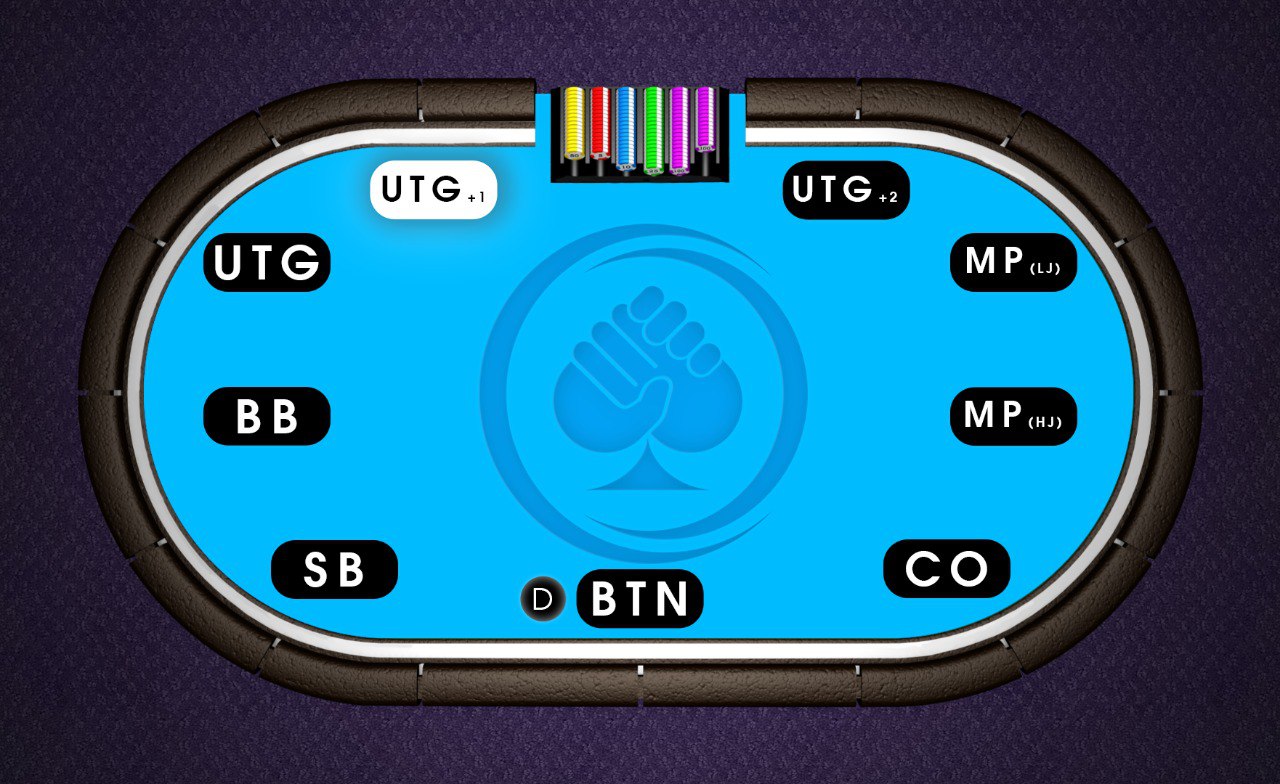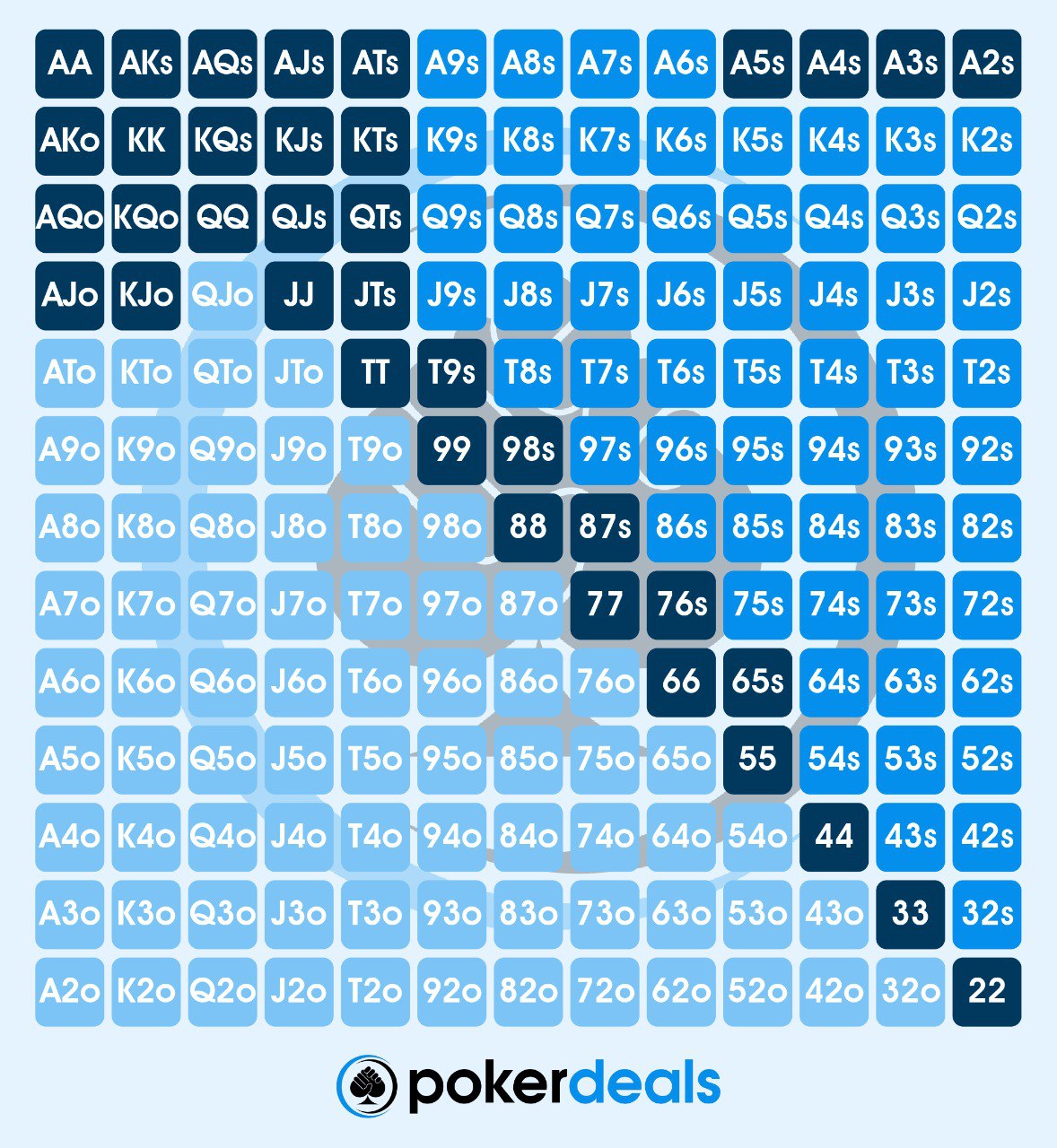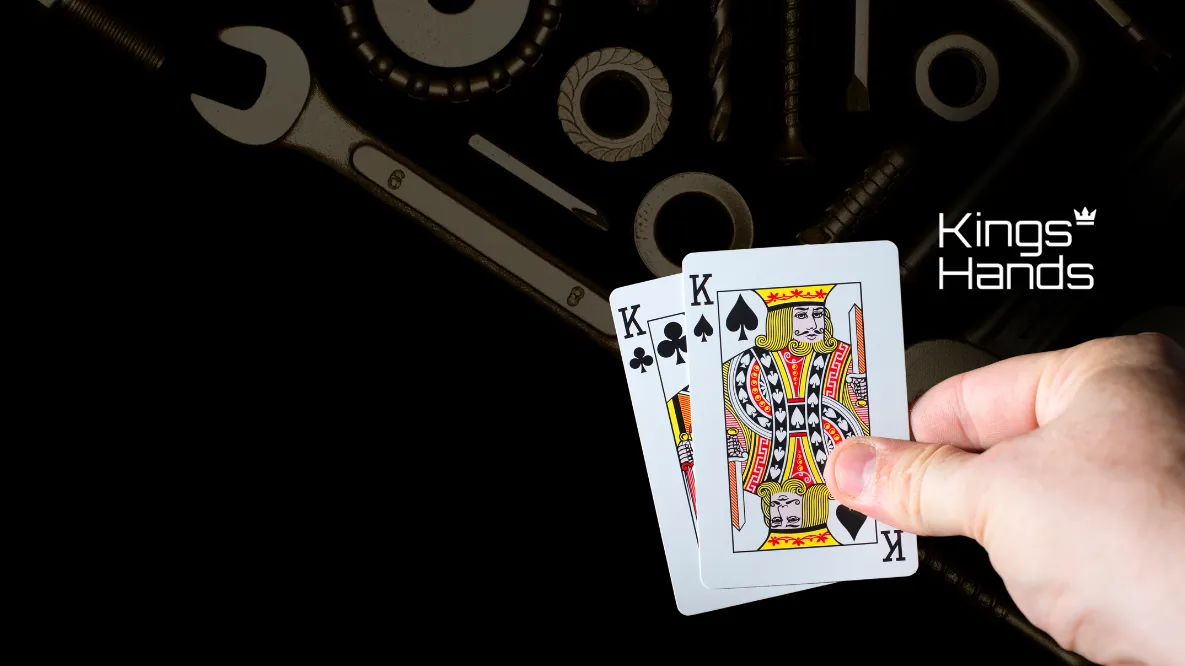Don’t worry, you haven’t clicked on the wrong page, this is a different article from the Under The Gun piece! Poker players aren’t often described as an imaginative bunch, so when it came to naming the table positions, a couple of them just have a number tacked onto the end!
Like its namesake, playing hands from under the gun+1 (or UTG+1) can be difficult for new players, so we’re going to take you through constructing your UTG+1 opening range, our suggested opening range, and how you should adjust to different table dynamics.
What is the Under The Gun+1 Position?
The under the gun+1 position is the position to the direct left of the under the gun position. At a nine-handed poker table, the UTG+1 position is the second position to act preflop, after under the gun.

How Should You Play From Under The Gun+1?
As you may be able to guess by the similarities in the name, you should play a similar range of hands from UTG+1 as you would from under the gun. Many of the disadvantages of playing from under the gun carry over to this position, although they are slightly softened by being one position over.
You still have the majority of the table left to act after you, so the likelihood of one of the seven remaining players having a strong hand is still high. You are also likely to be out of position when called, putting you at a further disadvantage postflop.
To combat this, you must play a tight, solid range full of strong hands. While you can add a few more hands into your opening range when playing from UTG+1, you still need to play extremely tight compared to other positions at the table. The combination of the number of players left to act behind you, plus your potential postflop disadvantage means that we cannot afford to play a large number of hands.
Many beginner players are unaware of this positional disadvantage and will play far too many hands from UTG+1. Doing so will eat into your potential win rate, as you’ll often be dominated by your opponent’s tighter range and you will find it hard to defend such a wide range postflop.
How Do We Construct an Under The Gun+1 Opening Range?
So, if we’re playing a tight range that’s not quite as tight as our under the gun range, what hands should we include? Well, it won’t surprise you to learn that the two ranges are going to look very similar.
We want to include a lot of strong Ax hands, strong pocket pairs and broadway hands, as well as a few more weaker pocket pairs and suited connectors. Given that our opponents are going to be defending against our opens with a tight range, we still want hands that are going to be dominating rather than dominated.
Hands like weak offsuit Ax are still not included, nor are weaker Kx, Qx, and Jx hands. These hands often make weak top pairs that are going to be hard to play postflop and could end up losing us a big pot. Folding hands like J8s may be hard for beginners as the hand looks pretty, but playing these hands will end up costing you in the long run.
UTG+1 Base Opening Range
At a nine-handed cash game table with 100bb, we recommend that your baseline UTG+1 range should look something like this:
16.14% – 22+, ATs+, A5s-A2s, KTs+, QTs+, JTs, T9s, 98s, 87s, 76s, 65s, AJo+, KJo+

As you can see above, the bulk of our range remains the same as our under the gun range, but we’ve added in a few more hands that become profitable from UTG+1. This theme will run throughout the series, as each position’s range is the baseline for the next – we never outright replace hands in our opening range, rather we build on the hands we raise from early position and add more as we move around the table.
We’ve added hands such as the weakest pocket pairs and a couple more suited connectors. While these hands are too often dominated from under the gun, playing one position over makes these hands become slightly more profitable, thus we are able to include them in our range.
However, as we’re still in early position, we can’t open up our range too much, otherwise, we’ll get exploited by our opponents. Adding in hands like J9s or QJo that are likely to be dominated postflop will reduce the overall profitability of our opening range, so we don’t include them this early.
Remember, this range is included as a recommended baseline – it’s not a hard and fast rule that you should stick to no matter what. If you feel comfortable playing a wider range, then go ahead and add in a few more hands; conversely, if you like to play a tighter style, there’s nothing wrong with removing a few hands from this range. Playing what you’re comfortable with will make you a much better player than someone who’s forcing themselves to play predetermined ranges.
Adjusting Your Range
While we advise you to adjust these ranges based on your personal playing style, you should also be looking at your table dynamic when considering which hands to open from UTG+1. Some table set-ups require you to alter your range to increase your profitability, and failing to do so is leaving money on the table.
Let’s take a look at how you should be adjusting your UTG+1 range when your table is playing excessively loose and excessively tight.
How You Should Adjust at a Tight Table?
If you’re playing at a table where players are overfolding against raises, it can be tempting to go wild and start stealing the blinds with a wide range from every position. However, when playing from UTG+1, you still have to deal with the disadvantages of your position. There are seven players left to act behind you, and the chances that someone wakes up with a playable hand are too great to start raising a wide range – even if they are overfolding.
However, you can exploit the tendencies of your opponent by widening your range; you just have to manage the extent to which you do so. Adding a few more hands into your opening range and bumping it up a few percentage points is the best way to win more than your fair share of pots preflop while not going overboard.
The best hands to add to your range are Ax hands like ATo and the rest of the Ax-suited hands, as well as the offsuit broadway hands that you weren’t raising before. Having high cards in your own hand blocks your opponent from potentially having a hand that can call or 3bet against your raise, increasing the likelihood that your preflop raise gets through.
How You Should Adjust at a Loose Table?
Adjusting to a loose table when playing from early position is quite easy to do, as very little adjustment is actually necessary! If players are playing too wide, your tight, solid UTG+1 opening range is going to dominate them the majority of the time, and you can exploit them by value betting aggressively postflop.
The hard part is trying to stick to your tight opening range, as it’s far too easy to get dragged down into the mud and start playing a wider range yourself in the hopes that you can stack someone in a big pot. From experience, the best way to stack one of these players in a big pot is by having a strong hand, so if you stick to your UTG+1 opening range, you should have no problems making money on a table that plays too loosely.
Summary
Just like its predecessor, the hard part about playing hands from UTG+1 is staying disciplined and sticking to your tight range. It’s not uncommon to go long stretches of hands without finding a playable hand, but you can’t let that affect your decisions.
Widening your opening range just to “get in the action” is going to cost you money in the long run, and a winning poker player knows that they will eventually be dealt the hands they should be playing from each position. As long as you stick to playing a tight range from UTG+1, there’s no reason why you can’t make it a profitable position.
Stay tuned for our next article on preflop opening ranges, where we’ll be covering the Under The Gun+2 position, by following us on Facebook and Instagram.





















